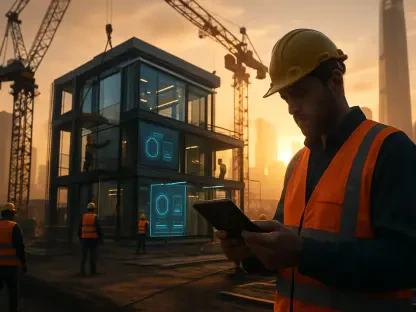Luca Calaraili is an expert in construction with extensive knowledge in design and architecture. He is passionate about exploring technology applications and tools that drive innovation within the industry. Today, we will discuss the evolution and the role of AI in smart buildings, the impact of connectivity, and the future potential of telcos in this market.
Can you explain the concept of smart buildings and how they have evolved?
Smart buildings integrate various technologies and systems to enhance the efficiency and management of building operations. Initially, these buildings focused on automation through the Internet of Things (IoT), placing sensors throughout to collect data. Over time, the evolution has led to more sophisticated systems that utilize artificial intelligence (AI) to analyze the data, making buildings more responsive and efficient in real-time.
What role does AI play in making smart buildings more efficient?
AI is crucial for processing the vast amounts of data generated by the sensors in smart buildings. It can analyze real-time data to optimize energy use, predict maintenance needs, and improve the overall comfort and security of the building. By doing this, AI helps convert raw data into actionable insights, making the management and operation of smart buildings significantly more efficient.
How can AI turn IoT-generated information into actionable insights in the context of smart buildings?
AI can quickly process the data collected from IoT devices, identifying patterns and trends that may not be obvious to human operators. This capability enables it to make predictions and provide recommendations on issues such as energy consumption, security threats, and maintenance requirements, thus allowing building managers to make informed decisions to improve overall building performance.
What is dashboard fatigue, and how does AI help in addressing this issue?
Dashboard fatigue occurs when users are overwhelmed by the sheer amount of data displayed on monitoring dashboards, making it difficult to focus on the most critical information. AI helps by filtering and prioritizing data, highlighting only the most relevant insights and recommended actions, which simplifies the decision-making process and reduces the cognitive load on users.
How significant is the growth of smart buildings in China, the U.S., and Europe?
The growth of smart buildings in these regions has been quite significant. According to estimates, there were 31 million smart buildings in China, 16 million in the U.S., and 18.9 million in Europe last year. This rapid expansion indicates a strong market demand for smart building technologies and services.
According to Parks Associates, what are the projected numbers for smart MDUs in the U.S. by the end of 2025?
Parks Associates projects that the number of smart multi-dwelling units (MDUs) in the U.S. will reach 35.4 million by the end of 2025. This indicates a steady adoption rate and increasing interest in smart technology in the residential sector.
How has the smart MDU market evolved over the past five years according to Elizabeth Parks?
Elizabeth Parks noted that the smart MDU market has evolved rapidly over the past five years, transitioning from a luxury amenity in select communities to wider adoption in the broader market. This growth is driven by the increasing recognition of the benefits of smart technologies in enhancing the quality of living and operational efficiency.
What is the impact of new housing construction on the smart MDU market?
The growth of the smart MDU market has slowed in parallel with new housing construction. However, retrofits of existing buildings continue to drive market growth, as property owners upgrade their facilities to incorporate smart technologies.
How are retrofits contributing to the growth of the smart building market?
Retrofits are a significant contributor to the growth of the smart building market. Upgrading existing structures with modern smart technologies allows building owners to improve building performance, increase property value, and offer enhanced amenities, even if they are not constructing new buildings.
Why is connectivity crucial for smart buildings and even more so for autonomous ones?
Connectivity is fundamental for smart buildings as it enables the communication between various sensors and systems. For autonomous buildings, which rely on real-time data processing and AI-driven decision-making, robust and reliable connectivity is even more critical to ensure that the systems function seamlessly and efficiently.
What are the cost implications of DIY connectivity solutions for smart buildings?
DIY connectivity solutions can be very costly due to the high installation expenses associated with wiring and setting up communication systems. For example, connecting a simple temperature sensor might incur significant costs, often around $1,000 per installation, which can be prohibitive for many building owners.
How do telcos eliminate the high installation costs associated with connecting IoT devices in smart buildings?
Telcos can eliminate these high installation costs by providing public and private 5G network infrastructures, which offer wireless connectivity solutions. This reduces the need for extensive wired installations, making it more affordable and agile to implement IoT devices in buildings.
Besides connectivity, what managed services can telcos offer to commercial and residential buildings?
Telcos can offer various value-added and managed services, including energy management and optimization, security and access control, predictive maintenance, climate control, and entertainment options. These services enhance the operational efficiency and living experience within smart buildings.
How can AI be used for energy management and optimization in commercial buildings?
AI can analyze energy usage patterns and predict future consumption needs. It can optimize heating, ventilation, and air conditioning (HVAC) systems, manage lighting, and even suggest modifications to improve energy efficiency, thus reducing operational costs and minimizing environmental impact.
What other value-added services can telcos provide for commercial buildings using AI?
Beyond energy management, telcos can provide services such as space management, capital planning, security solutions, access control, and predictive maintenance. These AI-driven services help enhance the overall efficiency and operational effectiveness of commercial buildings.
How can AI enhance the living experience in residential buildings?
AI can significantly enhance the residential living experience by automating home systems like lighting, climate control, and security. It can tailor these systems to the preferences and routines of the residents, providing greater convenience, comfort, and security.
What are some potential smart amenities that can grow in commercial and residential environments?
Potential smart amenities include intelligent climate control systems, automated security systems, remote access and control of building features, advanced entertainment setups, and energy management solutions. These amenities improve the user experience and add value to properties.
What technology platforms could telcos employ to offer new services and systems beyond connectivity?
Telcos could leverage platforms that integrate AI, IoT, and 5G networks to offer comprehensive solutions. Using these technologies, they can develop advanced services like energy management, security systems, remote monitoring, and predictive maintenance.
How can telcos leverage in-building connectivity to provide value-added services?
Telcos can use in-building connectivity to offer services such as remote management of building systems, real-time monitoring of building conditions, predictive analytics for maintenance, and enhanced security protocols. These services provide significant added value to building owners and occupants.
In what ways could telcos offer services related to safety and security for smart buildings?
Telcos could offer AI-driven security solutions such as smart surveillance cameras, access control systems, and automated emergency response services. These systems enhance the safety and security of buildings by providing real-time monitoring and quick response to potential threats.
How might telcos use AI for remote control of lighting and HVAC systems in buildings?
Telcos can implement AI systems that allow for the remote control and automation of lighting and HVAC systems. These systems can be accessed through mobile apps or centralized dashboards, enabling building managers to optimize energy use and maintain ideal conditions from anywhere.
What are the potential benefits of AI-driven energy savings for buildings?
AI-driven energy savings can lead to significant cost reductions, improved environmental sustainability, and prolonged equipment lifespan. By optimizing energy use, buildings can reduce their carbon footprint and contribute to overall sustainability goals.
How could telcos integrate AI for notifications of air quality and remote access services?
Telcos can deploy AI-integrated systems that monitor air quality in real-time, providing notifications and recommendations for maintaining optimal conditions. They can also offer remote access services that allow building managers or residents to control various building functions from anywhere, improving convenience and responsiveness.
How do add-on services like home security and parental controls fit into the telco business model?
Add-on services like home security and parental controls complement the core connectivity services offered by telcos, creating new revenue streams and enhancing customer satisfaction. These services provide additional value to customers, making telcos’ offerings more comprehensive and attractive.
Do you believe AI could unlock new revenue streams for telcos, and if so, how?
Absolutely, AI can unlock new revenue streams for telcos by enabling them to offer advanced, data-driven services. These could include predictive maintenance, energy management, security solutions, and personalized user experiences, all of which can be monetized effectively.
Why is the role of telcos critical in the future of smart buildings and AI integration?
Telcos are critical because they provide the essential connectivity infrastructure needed for smart buildings to function. Their expertise in networking and data management positions them uniquely to offer comprehensive solutions that integrate AI and IoT, driving the next wave of innovation in smart buildings.









